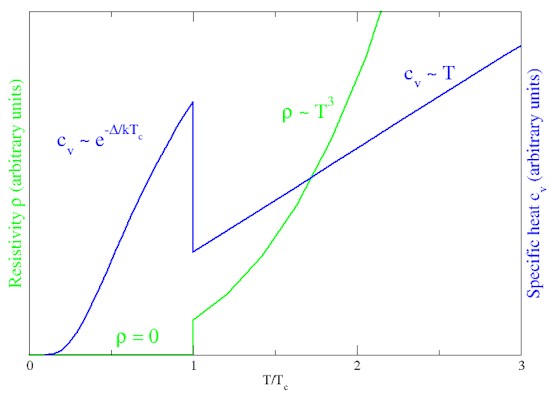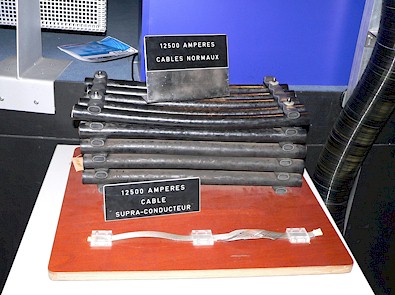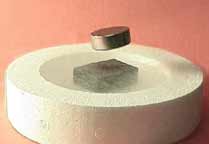|
Mainland High School
Cutting the Cord: ISTF 07-1726 |
||
|
Home
Introduction Components One Two  Product Product
Three Microwave Research W. C. Brown Generators History Phased Arrays Properties Rectennas Semiconductors Solar Satellites Superconductors Moon Research Colonization Helium-3 Fusion Geography Mining Resources Project Assessment Bibliography Glossary Team |
Superconductors
In normal electromagnetism, electricity is the movement or "flow" of electrons through a medium. In most atoms, electrons are strictly bound in orbit around the nuclei of individual atoms, making these materials bad conductors, or good insulators of electricity. However, in metals, the electrons are allowed to move more or less freely throughout the atoms, creating an electron "pool" within the material. This makes metals good conductors of electricity.
Certain metals are known to be better conductors than others. Metals such as gold, silver, and copper are such metals. They allow electrons to move a little more freely than others, making them ideal for electrical transfer. The degree to which a material prevents the free flow of electrons is known as resistance. This is alo a ratio of electric potential to electric current. The amount of electrical charge that moves by a point over a certain unit of time is called electric current. Charge is measured in Coulombs (1 Coulomb equals the total charge carried by 6.25 x 1018 electrons) and current is measured in Amperes, or Amps as they are commonly called, which is equivalent to one Coulomb per second. Electric potential is the amount of power behind a certain amount of current. Power is the amount of energy used in a certain amount of time. These are all expressed below in equation form. In the following equations, V is electric potential in Volts, I is electric current in Amperes, Q is electric charge in Coulombs, P is power in Watts, t is time in seconds, W is energy in Joules, and R is resistance in Ohms.  In conductors, as the temperature of the material decreases, the resistance decreases. Conversely, as the temperature increases, the resistance increases. Since energy is required to "push" a current through resistance, and since we know energy is conserved, this energy most go somewhere. It does. This energy is dissipated in the form of heat. This is the main reason why computers require fans and heat sinks to cool the electronics down. If they run too hot, they will run slower, and may damage certain electronic components. Similarly, if resistance stays the same and current increases, the conductor heats up, causing the resistance to increase, which in turn increases the energy required to move that current. This is why many high-voltage wires are thick, so that the electrons have a larger area to move through (think of it like adding lanes to a busy highway, or increasing the diameter of a water pipe.). The rate at which the resistance decreases, decreases with temperature. Even near absolute zero, the best normal conductors still have some noticeable resistance. Superconductors are not so, though. They have a resistance-temperature graph like most conductors, except that when they go below a certain critical temperature, their resistance becomes zero, as shown in the graph below. By the electric properties shown above, this means that the components can maintain a current with absolutely no power necessary. Experimental and theoretical data suggests that the amount of time required for the current to diminish to zero is at least 100,000 years, and could be higher than the expected lifetime of the universe. 
Image courtesy of Alison Chaiken This image is licensed under the Creative Commons Attribution-Share Alike 2.5 License These properties are advantageous for many reasons. The first, and most obvious reason, is that very little power if any, would be necessary to "push" large amounts of current through a super conducting circuit. An example of this, would be a satellite in orbit. It would take a lot of energy to get it into orbit, but once in a stable orbit, the object would theoretically remain in motion for as long as the body which it orbits remains stable. Another advantage is that it would not be necessary to cool it, as it would not produce heat (assuming it is in an environment with a temperature low enough for it to be a superconductor). Yet another advantage, is that it would only take a wire with minimal cross sectional area to carry a current of magnitude which would normally require huge clusters of wires to carry on normal conductors. Shown below, in an exhibit at CERN, is a comparison of the amount of wiring required to move 12,500 Amperes of current in conventional conductors, and the equivalent superconducting wiring. 
Image courtesy of User:Rama This image is licensed under the Creative Commons Attribution-Share Alike 2.5 License Another property of superconductors, is called the Meissner effect. In normal conductors, magnetic field lines travel directly through the volume of the material. However, in superconductors, the magnetic field lines are bent around the material, and retun to their original vectors beyond the object. This can lead to one form of magnetic levitation. The fieldlines bent around the object hold up the object in static equilibrium. The major drawback with superconductors, is that they must be cooled to extreme temperatures. Most superconductors display the above properties at temperatures close to absolute zero. The highest recorded temperature for a conventional superconductor is 39 K. However, a new group of superconductors has been found, known as "high-temperature superconductors," which exibit these traits at much higher temperatures. These have been proven to have superconducting properties at temperatures up to 91 K, and some have theorized higher temperatures. Centauri Dreams - Reconfigurable Structures in Space: Q & A http://www.centauri-dreams.org/?p=1703 HyperPhysics - Conductors and Insulators http://hyperphysics.phy-astr.gsu.edu/hbase/electric/conins.html HyperPhysics - Magnetic Levitation http://hyperphysics.phy-astr.gsu.edu/Hbase/solids/maglev.html HyperPhysics - Resistance: Temperature Coefficient http://hyperphysics.phy-astr.gsu.edu/hbase/electric/restmp.html HyperPhysics - The Meissner Effect http://hyperphysics.phy-astr.gsu.edu/hbase/solids/meis.html#c2 NDT - Conductors and Insulators http://www.ndt-ed.org/EducationResources/HighSchool/Electricity/conductorsinsulators.htm PhysicsLab - An Introduction to DC Circuits http://dev.physicslab.org/Document.aspx?doctype=3&filename=DCcircuits_IntroductionDC.xml PhysicsLab - Electrostatics Fundamentals http://dev.physicslab.org/Document.aspx?doctype=3&filename=Electrostatics_ElectrostaticsFundamentals.xml Superconductors.org - Superconductivity Explained http://superconductors.org/oxtheory.htm Superconductors.org - The First Non-Cuprate High-temperature Superconductor http://superconductors.org/91K.htm Superconductors.org - Type 1 Superconductors http://superconductors.org/Type1.htm University of Olso - Superconducting Levitation http://www.fys.uio.no/super/levitation/ Wikimedia Commons - Image:CERN-cables-p1030764.jpg http://commons.wikimedia.org/wiki/Image:CERN-cables-p1030764.jpg Wikimedia Commons - Image:Cvandrhovst.png http://commons.wikimedia.org/wiki/Image:Cvandrhovst.png |
